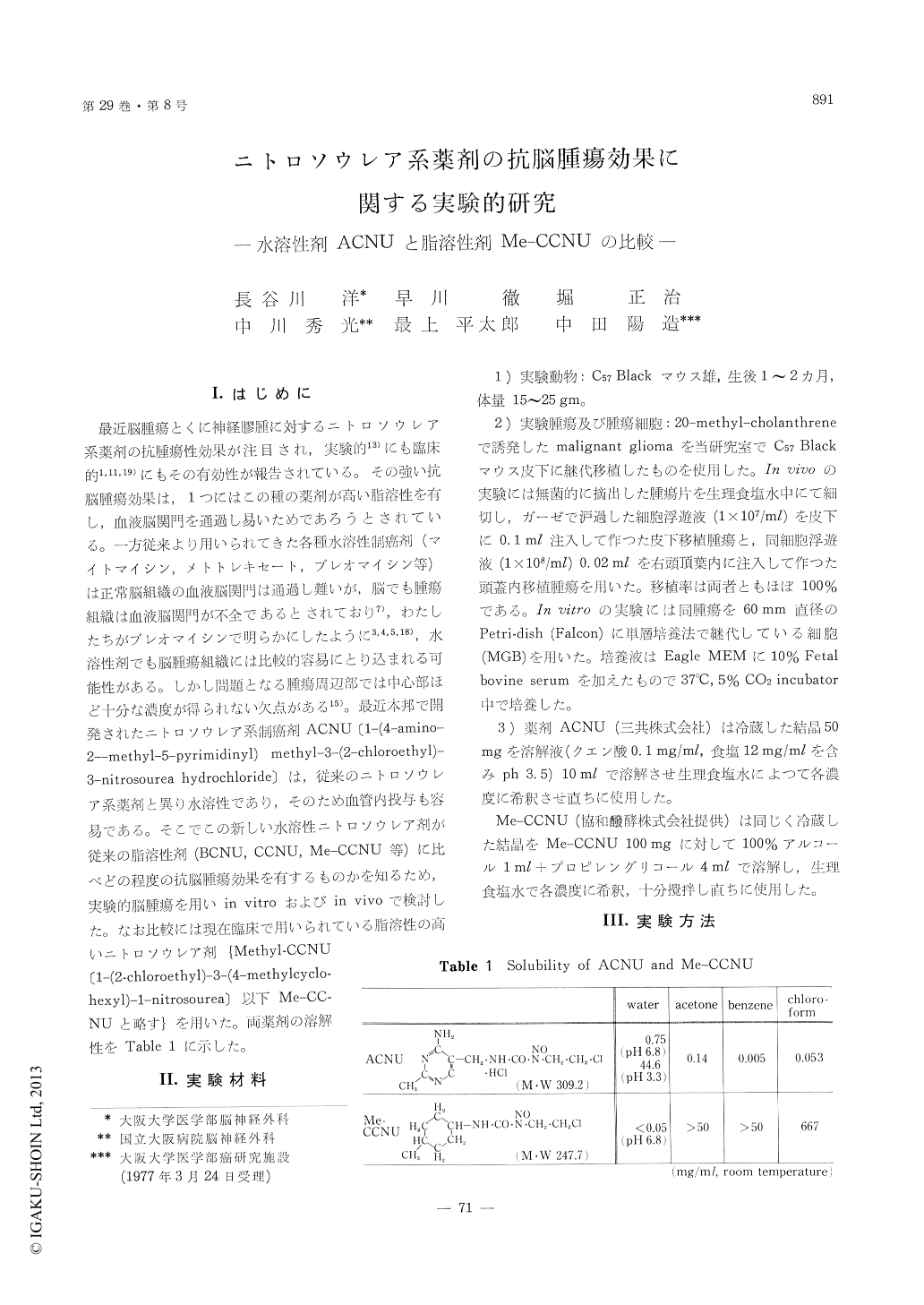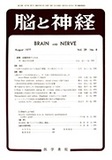Japanese
English
- 有料閲覧
- Abstract 文献概要
- 1ページ目 Look Inside
I.はじめに
最近脳腫瘍とくに神経膠腫に対するニトロソウレア系薬剤の抗腫瘍性効果が注目され,実験的13)にも臨床的1,11,19)にもその有効性が報告されている。その強い抗脳腫瘍効果は,1つにはこの種の薬剤が高い脂溶性を有し,血液脳関門を通過し易いためであろうとされている。一方従来より用いられてきた各種水溶性制癌剤(マイトマイシン,メトトレキセート,ブレオマイシン等)は正常脳組織の血液脳関門は通過し難いが,脳でも腫瘍組織は血液脳関門が不全であるとされており7),わたしたちがブレオマイシンで明らかにしたように3,4,5,18),水溶性剤でも脳腫瘍組織には比較的容易にとり込まれる可能性がある。しかし問題となる腫瘍周辺部では中心部ほど十分な濃度が得られない欠点がある15)。最近本邦で開発されたニトロソウレア系制癌剤ACNU〔1-(4-amino-2--methyl-5-pyrimidinyl)methyl-3-(2-chloroethyl)-3-nitrosourea hydrochioride〕は,従来のニトロソウレア系薬剤と異り水溶性であり,そのため血管内投与も容易である。そこでこの新しい水溶性ニトロソウレア剤が従来の脂溶性剤(BCNU,CCNU,Me-CCNU等)に比べどの程度の抗脳腫瘍効果を有するものかを知るため,実験的脳腫瘍を用いin vitroおよびin vivoで検討した。なお比較には現在臨床で用いられている脂溶性の高いニトロソウレア剤{Methyl-CCNU〔1-(2-chloroethyl)-3-(4-methylcyclo—hexyl)-1-nitrosourea〕以下Me-CC-NUと略す}を用いた。両薬剤の溶解性をTable 1に示した。
Nitrosoureas are widely used for the treatment of malignant brain tumors, because most of them are lipid soluble and are able to cross blood-brain barrier easily. Newly developed ACNU (1-(4-amino-2-methyl-5-pyrimidinyl) -methyl-3-nitrosourea hy-drochloride), however is water soluble nitrosourea. The effect of ACNU on experimental mouse brain tumor was examined in vitro and in vivo and compared with that of highly lipid soluble Me-CCNU. The tumor used was 20 methyl-cholanth-rene induced malignant glioma of C57 black mouse. Both ACNU and Me-CCNU markedly inhibited the growth of cultured glioma cell in the concen-tration of 5 microgram/ml,. The incorporation of 3H-thymidine and 3H-uridine into acid insoluble fraction of the glioma cells was strongly inhibited with 10~50 microgram/ml of both drugs but those of 3H-leucine were not clearly inhibited with same concentration of both drugs. Both drugs were very effective for the treatment of subcutaneously (s. c.) and intracranially (i. c.) transplanted malignant glioma and prolonged median survival time signifi-cantly. Maximun median survival time of percent control were followings; s. c. tumor, ACNU 333% (10mg/kg × 5), Me-CCNU 385% (5mg/kg × 5)-serial injection every other day, and ACNU 466% (20 mg/kg/4wks), Me-CCNU 319% (10mg/kg/4wks)-intermittent injection every 4 weeks until death. i. c. tumor, ACNU 293% (20mg/kg × 1), Me-CCNU 219% (20mg/kg × 1). Some animals with subcu-taneous tumor were completely cured but none survived in i. c. group.
There was no statistically significant difference between ACNU and Me-CCNU in terms of ef-fectiveness on survival time in both s. c. and i. c. tumors. ACNU seemed less toxic and was required more dose to get same results as Me-CCNU to treat s. c. tumors, probably because of heavier molecular weight (ACNU: 309. 2, Me-CCNU:247.7). Despite the fact that ACNU is water soluble, our experiment showed it was as effective as highly lipid soluble Me-CCNU on experimental brain tumor.
In order to avoid systemic toxic effect, regional chemotherapy is very advantageous especially for the treatment of central nervous system tumor which has almost no metastatic lesion. Since ACNU is known to be safely given intravenously, currently we are treating selected patients with malignant glioma by intra-carotid infusion of ACNU.

Copyright © 1977, Igaku-Shoin Ltd. All rights reserved.


